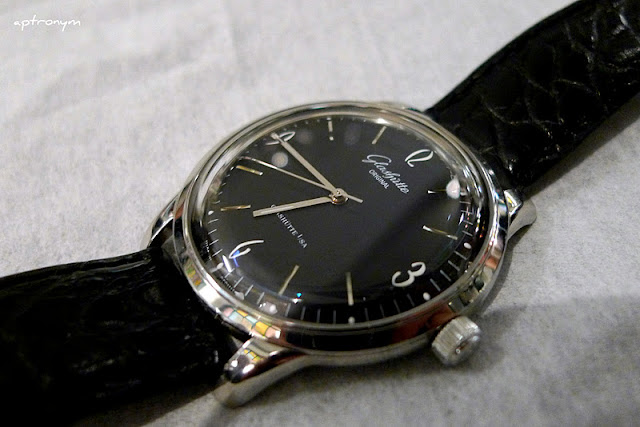With the end of 2011 nigh, Antiquorum's December "Important Modern & Vintage Timepieces" auction in New York will feature a mixed bag of 450 modern and vintage timepieces, and even some parts (see lots 323 to 327).
You can view the full catalogue
at this link but here are a couple of interesting (and sometimes quirky) timepieces that grabbed my attention. I am partial to lots 158 and 188. Descriptions and photographs are from the catalogue:
Lot 139 – Jaeger LeCoultre for Hermès, retailed by the latter. Movement No. 2176671, case No. 1315945. Made in the 1970's. Fine and rare, 18K yellow gold wristwatch with large lugs. Two-body, horizontal rectangular, polished and brushed, inclined bezel, extended lugs, winding-crown at 6. Satine silver with applied steel baton indexes. Steel baton hands. M. Cal. 818/2, tonneau, rhodium-plated, fausses cotes decoration, 17 jewels, straight lever escapement, monometallic balance, shock-absorber to balance and escape wheels, self-compensating fl at balance spring. Dial and movement signed. Dim. 42 x 30 mm. Thickness 7 mm.
Estimate: 1,000 USD - 2,000 USD
Estimate: 900 CHF - 1,700 CHF
Estimate: 700 EUR - 1,500 EUR
Lot 157 – Scarab beetle. Unsigned, Swiss, circa 1870. Fine gold and enamel, diamond-set pendant form watch designed as a scarab-beetle. Accompanied by a fitted box and key. Three part, underside chased and engraved with legs and underbody, wing covers entirely decorated in translucent red enamel over engine-turning with black spots, main body with black enamel stripes, the thorax with a diamond-set collar, spring loaded wing covers hinged and opening from a button in the base to reveal the dial. White enamel with Roman numerals. Blued steel "spade" hands. Oval 7"' 1/2 gilt brass, bar calibre with going barrel, 8 jewels, cylinder escapement and plain three-arm balance, fl at balance spring with regulator. Total length 46 mm.
Estimate: 15,000 USD - 20,000 USD
Estimate: 13,000 CHF - 17,000 CHF
Estimate: 11,000 EUR - 14,000 EUR
Lot 158 – Vacheron & Constantin Ref. 7323 white gold. Genève, No. 616631, case No. 49845. Circa 1970. Very fine and unusual, thin, keyless 18K white gold oval shaped pocket watch. Two body, polished bezel with satin reverse, cabouchon set winding crown. Silvered with painted Roman numerals. Blued steel index hands. Calibre. 1003 within oval steel holder, rhodium plated with fausses cotes decoration, 17 jewels, Geneva seal, straight-line lever escapement, blued steel balance spring adjusted to heat, cold, isochronism and 5 positions, index regulator. Dim. 35 mm x 47 mm.
Estimate: 2,800 USD - 4,300 USD
Estimate: 2,500 CHF - 3,800 CHF
Estimate: 2,000 EUR - 3,000 EUR
Lot 188 - Patek Philippe Telequartz. No. 842067. Circa 1975. Fine and rare, 220v., radio-controlled Module LS 0 electronic Master Clock. C. Rectangular, stepped, steel, black control panel with LCD display and buttons for setting. D. Electronic LCD digital display. M. Electronic, based on quartz oscillator, integral receiver Module AD 10SN, Serie 2384 receiver box. Dim. 24 x 33 x 7 cm.
Estimate: 1,500 USD - 3,000 USD
Estimate: 1,300 CHF - 2,600 CHF
Estimate: 1,000 EUR - 2,000 EUR
Lot 441 - Yellow gold top winder Vacheron & Constantin, Genève, No. 370816, case No. 262383. Made in the early 1930's. Very fine and rare, 18K yellow gold wristwatch. C. Three-body, solid, polished, concave lugs, winding crown at 12, domed crystal. D. Black with applied yellow gold Arabic numerals and baton indexes, outer minute divisions, subsidiary seconds dial. Yellow gold epée hands. M. Cal. 10 1/2''', gilt brass, 15 jewels, straight-line lever escapement, cut bimetallic compensation balance, blued steel fl at balance spring. Dial, case and movement signed. Diam. 30 mm. Thickness 8 mm.
Estimate: 4,300 USD - 7,000 USD
Estimate: 3,800 CHF - 6,000 CHF
Estimate: 3,000 EUR - 5,000 EUR
One of the stars of this auction, and the cover watch, is the Parmigiani Bugatti Type 370. This piece unique, with a 10-day power reserve, is in a stunning curved rectangular shape, its movement shaped like an automotive engine set inside an oval-shaped cylinder. The watch is wound and set via the underside, and comes with a “starter key”, in the manner of a car. The key is inserted into the winding hole to wind the watch, the “key’s” reverse is used to set the time. It also has 28 baguette diamonds.

Lot 180 – Parmigiani Fleurier “Bugatti” 18-carat white gold and diamonds. "Bugatti - Type 370," Piece Unique, case No. 23706. Made in 2007, sold January 27th, 2008. Accompanied by the original fitted box, travel box, certificate of origin, instructions and automatic winding pen. Extremely fine, rare and unusual, rectangular curved, movement constructed in the shape of an automotive engine encased in an oval-shaped cylinder, 18K white gold and diamonds driver's wristwatch with 10-day autonomy (displayed on a graduated drum) and an 18K white gold Parmigiani double deployant clasp. Accompanied by the original fitted box, travel box, certificate of origin, instructions and automatic winding pen.
Eight-body, solid, polished, transparent top, sides and back to view the movement, bezel set with 28 tapered baguette diamonds (approx. carat weight 3.1), case back with 4 screws, sapphire crystals. White gold with oeil-de-perdrix decoration, applied white gold EB (Ettore Bugatti) logo, luminous white gold baton indexes on a matte black outer reserve. Luminous white gold alpha hands. M. Cal. PF 370 oval mounted on silent blocks, rhodium-plated, 37 jewels, straight-line lever escapement, monometallic balance, shock absorber, self-compensating fl at balance spring, double-barrel. Dial, case and movement signed. Dim. 32 x 50 mm. Thickness 19 mm.
Estimate: 100,000 USD - 150,000 USD
Estimate: 90,000 CHF - 130,000 CHF
Estimate: 70,000 EUR - 105,000 EUR
Happy bidding!
[AP]






























































